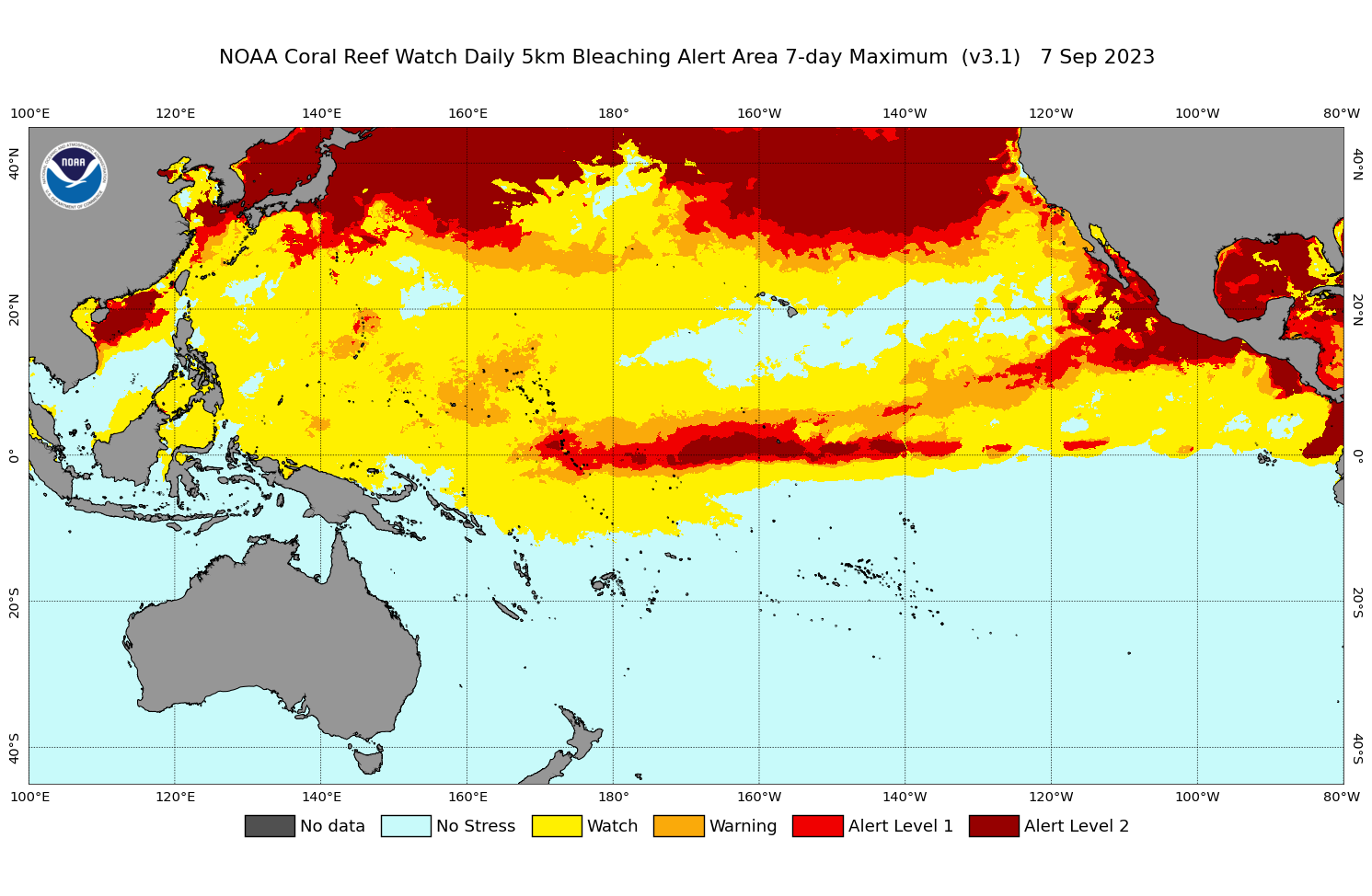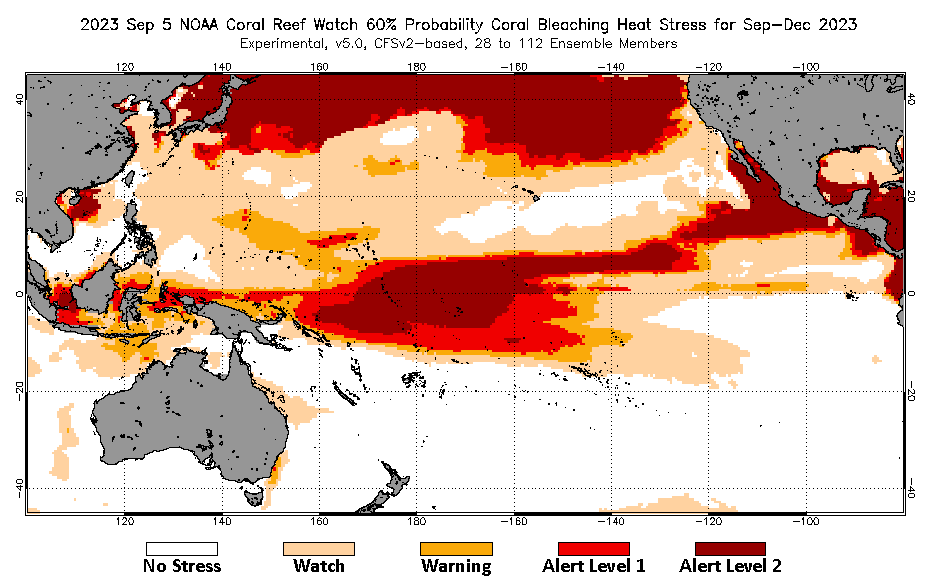Coral Bleaching Heat Stress Analysis and
Seasonal Guidance through December 2023
(Released September 8, 2023)
Current conditions:
NOAA Coral Reef Watch's near real-time satellite monitoring shows that as of September 7, 2023, above-average sea surface temperatures (SSTs) continue to persist across the entire equatorial Pacific Ocean. SST anomalies are highest in the eastern equatorial Pacific, with the strongest positive anomalies (as much as 5°C above normal) around the Galapagos Islands and the coast of Peru (Figure 1). A swath of below-average SSTs remains in the eastern North Pacific, stretching south and east from the Main Hawaiian Islands. In the Northwestern Hawaiian Islands (NWHI), above-average SSTs have begun to appear from Lisianski Island to Kure Atoll.
As of August 10, 2023, the NOAA National Centers for Environmental Prediction's (NCEP) ENSO Alert System status is: El Niño Advisory. El Niño is anticipated to continue through Northern Hemisphere winter (with greater than 95% chance through December 2023-February 2024).

|
||
|
Figure 1. NOAA Coral Reef Watch's Satellite Sea Surface Temperature (SST) Anomaly product for the Pacific region. |
||
Over the past three months, Coral Bleaching HotSpots >1°C have been concentrated in the central and eastern equatorial Pacific, with some areas of HotSpots >1°C intermittently appearing around Guam, the Commonwealth of the Northern Mariana Islands (CNMI), the Federated States of Micronesia (FSM), and the Marshall Islands (Figure 2). Since June, NOAA CRW's daily 5km satellite Regional Virtual Stations for the Northern Line Islands (which includes Jarvis Island, Kingman Reef and Palmyra Atoll), Howland and Baker Islands, and the Gilbert Islands, Kiribati, have all reached Alert Level 2 (Figure 3). At the same time, CNMI has elevated to Alert Level 1, while the Marshall Islands, Nauru, and the NWHI are at Bleaching Warning. To-date, NOAA CRW has not received any reports of bleaching in these locations.
***CRW would be very grateful if local stakeholders would share with us their in-water data and observations of coral bleaching/no bleaching, to inform what has been and is being observed on their reefs. Users can contribute their data to NOAA CRW via email (to coralreefwatch@noaa.gov), a Google Form, and/or via a more detailed, quantitative observations questionnaire. (Please see https://coralreefwatch.noaa.gov/satellite/research/coral_bleaching_report.php for more information.)***

|
||
|
Figure 2. NOAA Coral Reef Watch's Satellite Coral Bleaching HotSpot product for the Pacific region. |
||

|
||
|
Figure 3. NOAA Coral Reef Watch's Satellite Bleaching Alert Area (7-day maximum) product for the Pacific region. |
||
NOAA CRW's most recent, modeled Four-Month Coral Bleaching Outlook (Figure 4) projects heat stress will remain in the central equatorial Pacific Ocean during Northern Hemisphere summer and expand around the eastern Pacific off the coast of Mexico by October 2023. Additionally, Alert Level 2 heat stress is predicted to persist around the Northern Line Islands and the Gilbert Islands, Kiribati through November. The Marshall Islands may see Alert Level 2 conditions by the start of November. CRW is continuing to monitor a large swath of heat stress to the north of the NWHI, which is now predicted to stay north of the region and have limited impacts during September and October.

|
||
|
Figure 4. NOAA Coral Reef Watch's Four-Month Coral Bleaching Outlook of September 5, 2023, for September-December 2023, for the Pacific region. |
||
***CRW recommends regular review of its Four-Month Coral Bleaching Outlook maps (https://coralreefwatch.noaa.gov/satellite/bleachingoutlook_cfs/index.php) and near real-time satellite product updates (https://coralreefwatch.noaa.gov/product/5km/index.php), for all regions of interest/concern, over the months ahead.***
CRW's current satellite and modeled products can be found at:
https://coralreefwatch.noaa.gov/index.php
CRW's modeled Four-Month Coral Bleaching Heat Stress Outlooks can be found at:
https://coralreefwatch.noaa.gov/satellite/bleachingoutlook_cfs/outlook_cfs.php
CRW's 5km satellite Regional Virtual Stations can be found at:
https://coralreefwatch.noaa.gov/product/vs/map.php
Sign up for automated bleaching alert emails for CRW's 5km Regional Virtual Stations at:
https://coralreefwatch.noaa.gov/subscriptions/vs.php
Please report bleaching events (or non-events) at:
https://coralreefwatch.noaa.gov/satellite/research/coral_bleaching_report.php
Disclaimer
The content posted on this web page solely represents the opinions of the authors and does not constitute a statement of policy, decision, or position on behalf of NOAA or the US Government.
The appearance of external links on this World Wide Web site does not constitute endorsement by the Department of Commerce/National Oceanic and Atmospheric Administration of external Web sites or the information, products or services contained therein. For other than authorized activities, the Department of Commerce/NOAA does not exercise any editorial control over the information you may find at these locations. These links are provided consistent with the stated purpose of this Department of Commerce/NOAA Web site.